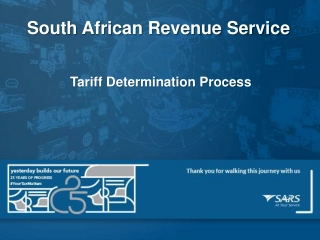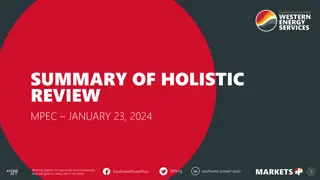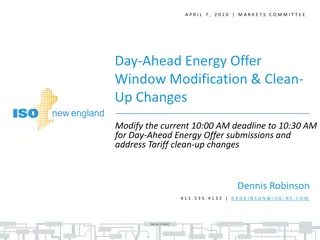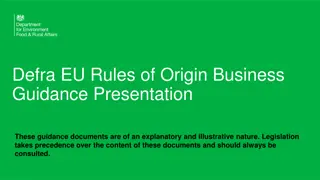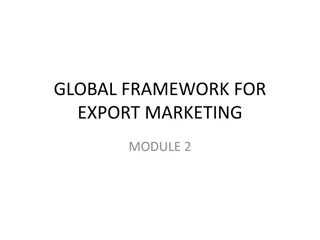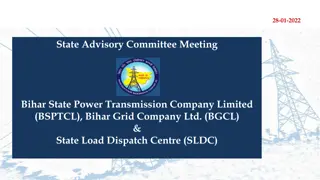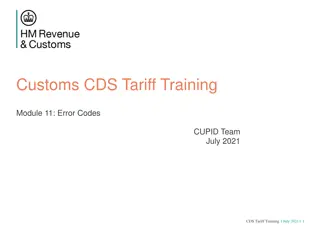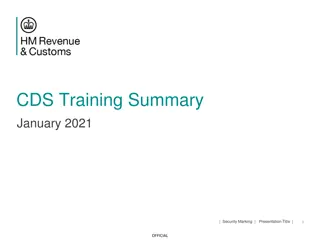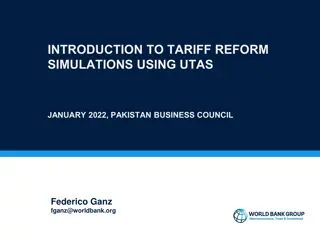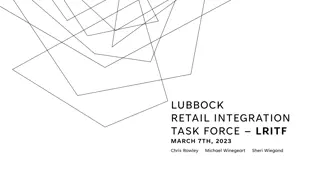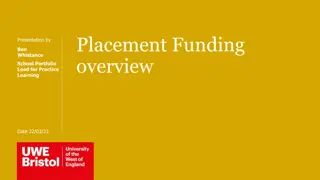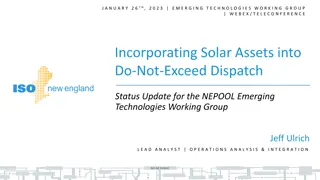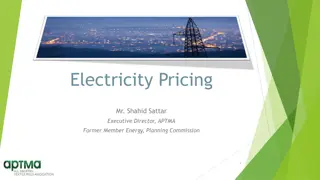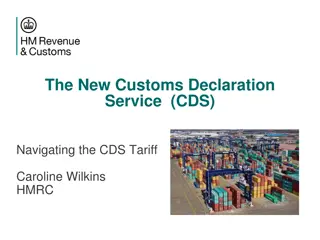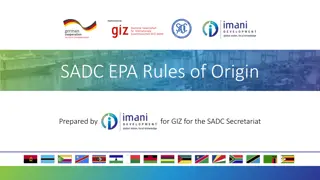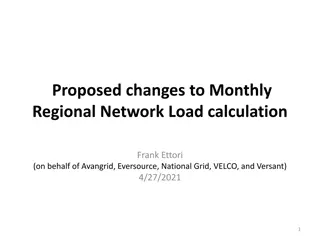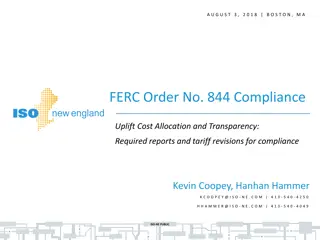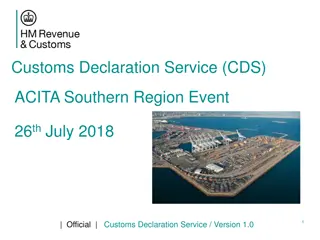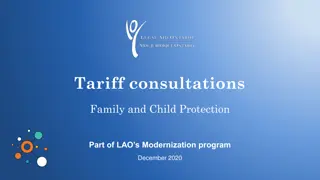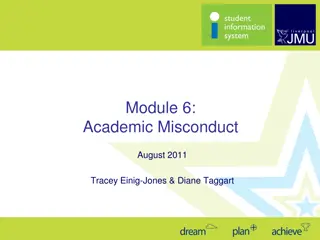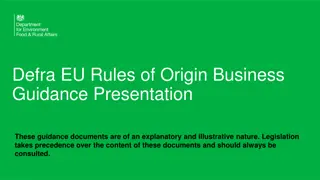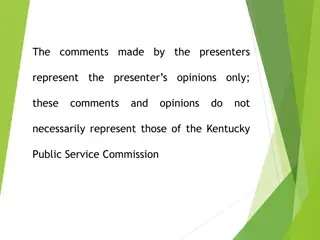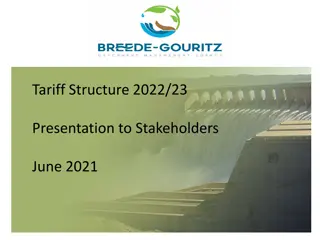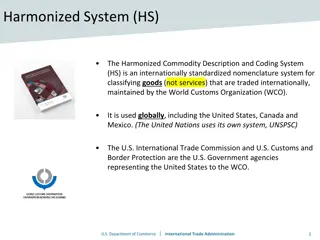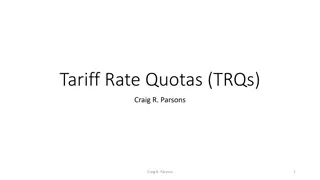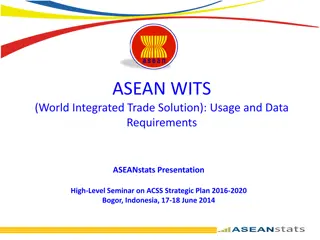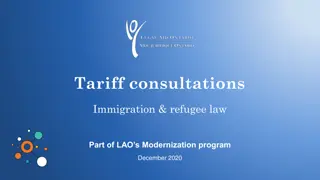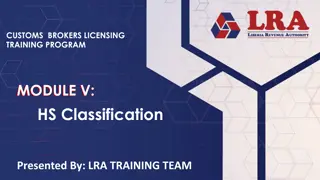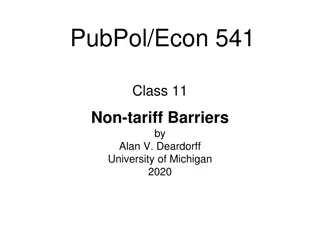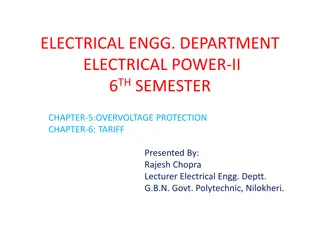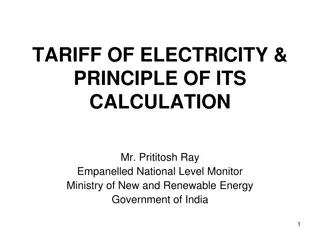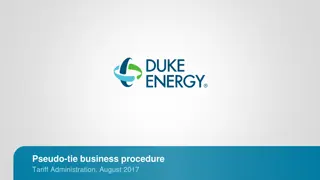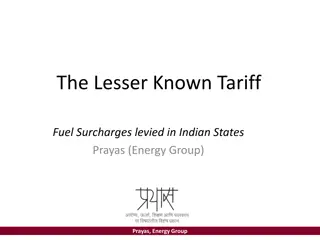Understanding SARS Tariff Determination Process
Explore SARS procedures for tariff determination and legislation provisions. Discover key discussions on customs, compliance, and international conventions.
1 views • 47 slides
Summary of Holistic Review of MPEC Tariff
Provide a summary of the holistic review conducted by SPP Staff on the MPEC Tariff, covering both non-substantive and substantive changes made for review and approval by MDWG. The review includes critical dates, tariff outline, updates from working groups/task forces, and a detailed table of content
0 views • 11 slides
Proposed Modification of Day-Ahead Energy Offer Window Deadline
ISO-NE is proposing a modification to the Day-Ahead Energy Offer Window by changing the submission deadline from 10:00 AM to 10:30 AM. This adjustment aims to provide suppliers additional time to consider information before finalizing their day-ahead offers and bids. The proposal also includes Tarif
0 views • 12 slides
Understanding Rules of Origin and Tariff-Free Trading with the EU
Rules of Origin (RoO) determine the economic nationality of a product, impacting tariffs and restrictions. To trade tariff-free with the EU, compliance with RoO is crucial. Specific rules dictate ingredient sourcing, with certification processes ensuring eligibility for tariff reductions. Certain pr
0 views • 19 slides
Understanding Trade Barriers and Tariff Classification
Explore the concept of trade barriers, including tariff and non-tariff barriers, their objectives, types, and classification. Learn about the benefits of tariff barriers, like discouraging imports and protecting home industries, and the classification of non-tariff barriers such as the quota system
3 views • 28 slides
Advisory Committee Meeting Summary for BSPTCL, BGCL & SLDC
The meeting discussed various topics including tariff petitions, business plans, network status, capacity additions, and cost optimizations for BSPTCL, BGCL, and SLDC in Bihar. Tariff projections, revenue requirements, transmission charges, and revenue surpluses were also analyzed and carried forwar
0 views • 23 slides
Understanding Error Codes in Customs CDS Tariff Training Module 11
This module focuses on interpreting error messages, identifying issues, and correcting errors in Customs CDS Tariff declarations. Learn about error code reference numbers, error descriptions, error locations, and how to fix common issues. Gain insights into cross-validation errors and protective mar
0 views • 13 slides
CDS Training Summary January 2021: Security Marking Presentation
In the CDS Training Summary for January 2021, the focus is on navigating the CDS Volume 3 Tariff, covering declaration categories, data elements, procedure codes, additional information codes, document codes, and more. The training provides a step-by-step guide on using the CDS Tariff, Volume 3, for
0 views • 69 slides
Understanding Tariff Reform Simulations Using UTAS
This presentation introduces tariff reform simulations using UTAS in the context of the car economy example. It covers how tariffs on imported goods impact production costs and effective protection of domestic industries. Key concepts such as output tariff, upstream tariff, and effective protection
0 views • 15 slides
Lubbock Retail Integration Task Force Updates
The Lubbock Retail Integration Task Force (LRITF) discussed major implementation items essential before LP&L can compete. Items include tariff goals, data sharing resolutions, and legislative changes for customer choice billing. The transition timeline outlines important milestones for LP&L's entry
0 views • 11 slides
Overview of Funding for Practice Placements in Healthcare Education
This presentation by Ben Whistance provides an in-depth overview of the recent changes in funding for practice placements in healthcare education, detailing the shift from invoicing practices to direct payments from Health Education England (HEE). It covers the new tariff rates for Nursing, Allied H
0 views • 7 slides
Incorporating Solar Assets into Do-Not-Exceed Dispatch: Project Update
This update covers the approval and timeline of incorporating solar assets into the Do-Not-Exceed (DNE) dispatch by ISO New England. The NEPOOL Participants Committee approved the project on September 1, 2022. Tariff changes were filed with FERC on November 30, 2022, and were accepted with an effect
1 views • 10 slides
Understanding Electricity Pricing and Tariff Structure in Pakistan
Electricity pricing involves costs of power plant operations and grid maintenance, impacted by factors like fuel cost, regulations, and consumer demand. Pakistan's tariff structure uses an incremental block tariff system to manage usage, with mechanisms set by regulators for fair pricing and afforda
0 views • 16 slides
Comprehensive Guide to the New Customs Declaration Service (CDS)
Navigating the CDS Tariff, UCC alignment, strategic facilitations for UK business, and essential information on the Customs Declaration Service. Learn about data elements, tariff publications, and key changes under CDS for a comprehensive understanding of the trade environment.
0 views • 27 slides
Technical Soundness of EU-SADC EPA Rules of Origin
The implementation and technical soundness of Rules of Origin under the EU-SADC EPA are crucial for the utilization of trade preferences. Compliance with rules of origin is essential for receiving tariff preferences, but drafting these rules accurately is challenging. Recommendations include specify
4 views • 12 slides
Updates on Generator Interconnection Procedures and Agreements Reform
ISO-NE is implementing further compliance reforms in response to FERC Order No. 845 regarding Generator Interconnection Procedures and Agreements. This includes proposed tariff language updates and discussions on surplus interconnection services. The changes aim to enhance the efficiency and effecti
0 views • 14 slides
Understanding Tariff Systems in Mathematical Literacy - NQF Level 2
Exploring tariff systems in Mathematical Literacy at NQF Level 2, focusing on phone tariffs, calculations, and understanding bundled deals. Learn about different types of tariffs, their costs, and how to analyze and calculate monthly expenses for various phone plans.
0 views • 24 slides
Proposed Changes to Monthly Regional Network Load Calculation and Tariff Language
This proposal outlines changes to the Monthly Regional Network Load (RNL) calculation and tariff language for Avangrid, Eversource, National Grid, VELCO, and Versant. It emphasizes the usage of Monthly RNL in the Open Access Transmission Tariff (OATT) and its impact on Network Customers. The propose
0 views • 7 slides
FERC Order 844 Compliance: Uplift Cost Allocation and Transparency
FERC Order 844, issued in April 2018, mandates reporting on uplift payments and unit commitments, along with revising tariff language for compliance. ISO-NE is proposing new reports and tariff revisions to adhere to the Order, enhancing transparency in operational practices. The Order aims to improv
1 views • 30 slides
New UCAS Tariff for Higher Education Entry Overview
UCAS has introduced a new Tariff for higher education entry starting from September 2017. This toolkit is designed to assist teachers and advisers in understanding the changes, timeline, points system, university examples, myth debunking, and available resources. The aim is to prepare educators and
0 views • 32 slides
Changes Introduced by Customs Declaration Service (CDS)
The Customs Declaration Service (CDS) brings significant changes, shifting from EDIFACT to XML format, enhancing technical communication methods, transitioning to digital reporting, and updating tariff publication guidelines. It requires completion using data elements instead of box numbers, allowin
0 views • 32 slides
Overview of LAO's Tariff Consultations for Family and Child Protection Modernization Program
LAO is seeking input on tariff reform as part of its modernization program to enhance Ontario's legal aid system. The focus is on immediate, cost-neutral updates and future potential increases. Feedback will help simplify billing rules, improve online services, and streamline access to information,
0 views • 15 slides
Understanding LJMU Penalty Tariff for Academic Misconduct
The LJMU Penalty Tariff, implemented from September 2011, ensures fair and consistent penalties for academic misconduct at LJMU. Points are allocated based on criteria, with penalties ranging from allowing new work submissions to expulsion. AMP outcomes are recorded using Service Indicators that rem
0 views • 17 slides
Preparing Energy Storage Systems for Public Safety Power Shutoff Events
Modernizing the NEM tariff to allow pre-PSPS charging involves utilities proposing modifications to allow energy storage systems to temporarily import energy from the grid upon advanced notification of a PSPS event. This process includes coordination with developers/aggregators and consultation with
0 views • 7 slides
PEIA Open Enrollment Plan Year 2023 - Important Updates
PEIA Open Enrollment for the Plan Year 2023 is scheduled from April 2 to May 15. Changes made during this period will be effective from July 1. Benefit Coordinators must approve any changes by May 20. Members can make changes by visiting the PEIA website, calling the helpline, or filling out forms o
0 views • 36 slides
Understanding Rules of Origin in EU-UK Trade
Rules of Origin (RoO) are essential in determining the economic nationality of products for tariff classification in EU-UK trade. Compliance with RoO is necessary for accessing preferential tariff rates under free trade agreements. This guidance outlines the principles, conditions, and requirements
0 views • 19 slides
Kentucky Public Service Commission Overview
Kentucky Public Service Commission (PSC) is responsible for regulating non-recurring charges, purchased water adjustments, and ensuring utilities adhere to tariff regulations. The PSC provides forms and guidelines for cost justifications and filings, along with information on utility regulations. Th
0 views • 40 slides
Stakeholders Presentation on 2022/23 Tariff Structure
Consultation with stakeholders on the proposed Water Resource Management Charges for the 2022/23 financial year by the Breede-Gouritz Catchment Management Agency. The presentation covers operational capacity, strategic priorities, tariff process, and budget planning processes aligned with National T
0 views • 15 slides
Understanding the Harmonized System (HS) for International Trade
The Harmonized System (HS) is an internationally standardized nomenclature system for classifying goods traded internationally, managed by the World Customs Organization (WCO). It organizes goods into categories down to the 6-digit level, providing a common set of descriptive categories for global t
0 views • 10 slides
Understanding Tariff Rate Quotas (TRQs) in International Trade
Tariff Rate Quotas (TRQs) are commonly used in global trade, particularly in agricultural imports. They involve lower tariff rates on imports up to a specified quantity per year, with higher rates applied to any excess imports. This system aims to regulate trade and protect domestic producers. TRQ l
0 views • 10 slides
ASEAN WITS: Integrated Trade Solution and Data Requirements
ASEAN WITS (World Integrated Trade Solution) is a software developed by the World Bank in collaboration with other organizations to facilitate trade data analysis, negotiation, and simulation within ASEAN countries. The customization of WITS aims to provide wider public accessibility to trade data.
0 views • 27 slides
Legal Aid Ontario's Tariff Consultations and Modernization Program
Legal Aid Ontario (LAO) is modernizing its legal aid system to better serve the community by seeking input on tariff reforms, improving access to information, and redesigning Legal Aid Online. Through cost-neutral updates, LAO aims to enhance efficiency and accountability while ensuring fair payment
0 views • 16 slides
Customs Brokers Licensing Training Program Module V: HS Classification Overview
Enhance your knowledge and skills in customs brokerage to pass the licensing uniform examination successfully. This module covers the evolution of customs nomenclature, reasons for tariff classification, HS structure, and more essential topics. Participants will learn to define technical terms, comp
0 views • 38 slides
Understanding Non-Tariff Barriers in International Trade
Explore the types of Non-Tariff Barriers (NTBs) and Non-Tariff Measures (NTMs) such as quotas, Tariff-Rate Quotas (TRQs), Voluntary Export Restraints (VERs), and more. Learn about Administered Protection, Safeguards tariffs, Anti-dumping duties, Countervailing duties, and their implications on trade
0 views • 57 slides
Electrical Engineering: Overvoltage Protection and Tariff Concepts
In the field of electrical engineering, it is crucial to understand overvoltage protection mechanisms to safeguard against electrical surges caused by internal and external factors like switching surges and lightning. Various protection methods such as ground wires, earthing screens, and lightning a
0 views • 12 slides
Understanding Tariff of Electricity and Principles of Calculation
Electrical energy production involves costs that are shared by consumers based on the amount and nature of electricity consumed. This includes fixed costs for setting up power plants and variable costs for generating electricity, which covers fuel expenses. The calculation of electricity costs is ba
0 views • 18 slides
Dafili Socio-Economic & Tariff Study Presentation Summary
Presentation delivered by Mike Wood at a CMP meeting in Dukem on June 19, 2013, focused on a socio-economic and tariff study for the Dafili community. The study aimed to gather demographic data, assess the community's ability and willingness to pay for water, recommend affordable tariffs, and evalua
0 views • 29 slides
Lubbock Retail Integration Task Force Updates and Resolutions
Lubbock Retail Integration Task Force (LRITF) discusses key implementation issues for LP&L entering competition, including Retail Access Tariff, CSA & Mass Transition Transaction Workflows, Customer Data, and Customer Choice Billing. Updates on resolving existing tariff restrictions and ERCOT functi
0 views • 10 slides
Pseudo-Tie Business Procedure Tariff Administration, August 2017
Pseudo-tie business procedure tariff administration from August 2017 outlines the purpose, implementation, and types of pseudo-ties in the energy industry. It covers dynamic transfers, pseudo-tie procedures, and various stakeholder involvements. The document details the process of implementing pseud
0 views • 11 slides
Analysis of Lesser Known Tariff Fuel Surcharges in Indian States by Prayas Energy Group
This report by Prayas Energy Group delves into the lesser-known tariff fuel surcharges levied in 15 Indian states, highlighting the processes, practices, and policy implications. Fuel surcharges are crucial for addressing power procurement cost deviations and play a significant role in DISCOM viabil
0 views • 26 slides
